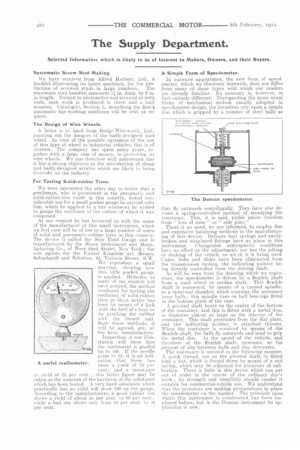The Supply Department.
Page 20

If you've noticed an error in this article please click here to report it so we can fix it.
Systematic Screw Stud Making.
We have received from Alfred Herbert., Ltd., a booklet illustrating its latest machines, for the production of screwed studs in large numbers. The maximum stud handled measures 11in. diam. by 9 in, in length. Turned to micrometer and screwed at both ends, such work is produced in three and a half minutes. Catalogue, Section 1,, describing the firm's automatic bar-working machines will be sent on request.
The Design of Wire Wheels.
A letter is to hand from Rudgc-Whitworth, Ltd., pointing out the dangers of the badly-designed wire wheel. In view of the possible extension of the use of this type of wheel to industrial vehicles, this is of interest. The company has spent many years, together with a large sum of money, in perfecting its wire wheels. We can therefore well understand that it has a strong objection to the introduction of cheap and badly-designed articles which are likely to bring diecredit on the industry.
For Testing Solid-rubber Tires.
We were interested the other day to notice that a gentleman, who is prominent in the pneumatic and solid-rubber-tire trade in this country, found considerable use for a small pocket gauge he carried with him, which he applied to a tire whenever he wished to gauge the resilience of the rubber of which it was composed.
At our request he has favoured us with the name of the manufacturer of this small instrument, which we feel sure will be of use to a large number of users of solid and .pneumatie-rubber tires in this country. The device is called the Sico Yield Gauge and is manufactured by the Shore instrument and Manufacturing Co., of West 22nd Street, New York ; the sole agents for the United Kingdom are Mews. Schuchardt and Schutter, 34, Victoria Street, S.W. '4Ve reproduce a small drawing, showing how this little pocket gauge is applied. Hitherto, as ninny of our readers will have noticed, the method employed for testing the resiliency of solid-rubber tires at short notice has been by means of a kick with the heel of a boot or by pinching the rubber with the thumb nail. Roth these methods, it will be agieed, are, at the best, unsatisfactory.
'Inspection of our illustration will show that the instrument is graded up to 100. If the needle point to 25, it is an indication that there has been a yield of 75 yei. cent., and a resistance to yield of 25 per tent. ; this latter figure may be taken as the measure of the hardness of the substance which has been tested. A very hard substance which practically has no yield will show 100 on the gauge. According to the manufacturers, a good rubber tire shows a yield of about 55 per cent. to GO per cent., while a bad one shows only from 35 per cent. to 40 per cent.
A useful resiliometer. A Simple Form of Speedometer.
in outward appearance, the new form of speedometer, which we illustrate herewith, does not differ from many of those types with which our readers are already familiar. Its anatomy is, however, in fact entirely different. Disregarding the more usual forms of mechanical motion usually adopted in speedometer design, the inventors rely upon a simple disc which is gripped by a number of steel balls as they fly outwards centrifugally. They have also devised a spring-controlled method of steadying the resistance. This, it is said, yields entire freedom from " loss of time " or " side play." There is no need, we are informed, to employ fine and expensive balancing methods in the manufacturing of this device. Delicate hair springs and easilybroken and misplaced fittings have no place in this instrument. Changeable atmospheric conditions have no effect on the adjustment, nor has the jolting or shaking of the vehicle on wh.ch it is being used. Cams, links and slides have been eliminated from the transmission motion, the indicating pointer being directly controlled from the driving shaft. As will be seen from the drawing which we reproduce, the speedometer is driven by a flexible shaft from a road wheel or ca.rdan shaft, This flexible shaft is connected, by means of a turned spindle, to ii, spherical chamber which contains the necessary loose balls ; this spindle runs on ball bearings fitted in the bottom plate of the case.
A pivoted shaft bears on the centre of the bottom of the container, and this is fitted with a metal disc, in diameter almost as large as the interior of the container. This shaft protrudes from the dial plate, and the indicating pointer is attached thereto. when the container is revolved by means of the flexible shaft, the balls fly outwards and tend to grip the metal disc. As the speed of the vehicle, and therefore of the flexible shaft, increases, so the amount of filip between balls and disc decreases.
The resistance is secured in the following manner. A quick thread, cut on the pivoted shaft, is fitted with a nut, which is forced down by means of a coil spring, which may be adjusted for purposes of calibration. There is little in this device which can get out a order in the course of the ordinary day's work ; its strength and simplicity should render it suitable for commercial-vehicle use. We understand that the inventors are making preparations to place the sneedorrieter on the market. The principle upon which this instrument is constructed has been employed before, but in the Duncan instrument its application Is new.






















